Of all the fandoms we celebrate here at GeeklyInc.com, there’s been rather a dearth of cartoon-horse-related content. Aside from a little bit of the Tiny Horsies RPG on our Twitch stream (with an upcoming special feature at GeeklyCon in June), we haven’t had much to say about the zeitgeist’s favorite friendship saga.
But My Little Pony: Friendship Is Magic Season 6 has just started, so it seems as good a time as any to review the My Little Pony Collectible Card Game (MLP CCG), which just so happens to have a new expansion (Marks in Time) due in a little over a month. (Full disclosure: I am an external playtester for the MLP CCG, and did playtest work for Marks in Time.)
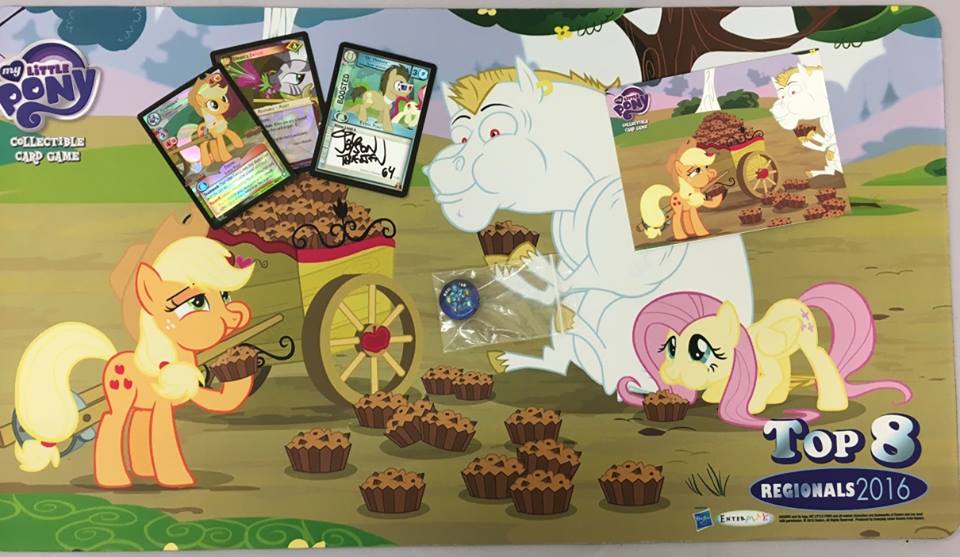
Also Top 8 at 2016 Regionals (#sickbrags).
What do you get when you combine Friendship Is Magic with the CCG genre? Actually, you get a deep and interesting game that’s a blast to play and build decks for.
It’s an Easy Feat (to Play)
The object of the MLP CCG is to solve Problems around Ponyville with the help of your Friends. When you confront Problems (contributing towards solving them), you score points, and the first player to reach 15 points wins the game.
The heart and soul of the game are the Friends, of course, which are the cards that represent the ponies, critters, and other colorful inhabitants of the My Little Pony world:
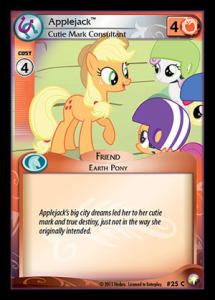
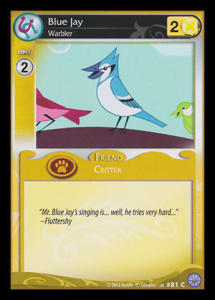
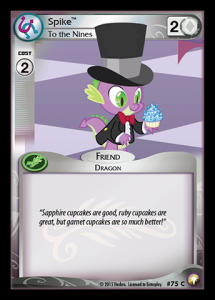 Essentially the equivalent of other games’ “creatures” or “minions,” each Friend has a power score in the upper right-hand corner of their card, which shows how strong the card is in play. Friends are also organized into six colors, each themed after one of My Little Pony‘s “mane six” characters—purple, white, yellow, orange, blue, and pink. As with most games that feature factional divisions, each color has particular mechanical strengths and weaknesses.
Essentially the equivalent of other games’ “creatures” or “minions,” each Friend has a power score in the upper right-hand corner of their card, which shows how strong the card is in play. Friends are also organized into six colors, each themed after one of My Little Pony‘s “mane six” characters—purple, white, yellow, orange, blue, and pink. As with most games that feature factional divisions, each color has particular mechanical strengths and weaknesses.
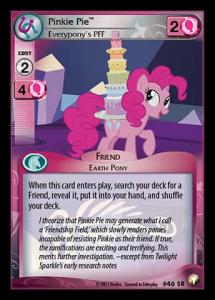
Some cards have an “entry requirement” just below their cost, expressed as a number and a color. If you don’t have that much power of that color (counting all your Friends in play in the game), you can’t play those Friends yet. These cards tend to be powerful, but necessitate a commitment to their colors. Usually, you can play two or three colors in a single deck, so you need to make choices about what to prioritize.
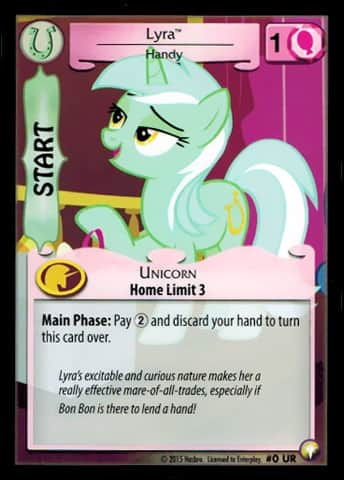
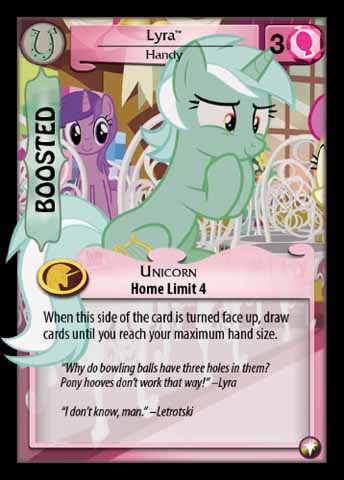 Each MLPCCG deck is also built around a “mane” (main) character. These are double-sided cards that start in play on your side and help to define the colors and themes of your deck. They provide some power for meeting entry requirements from the get-go. Over the course of play manes will flip to their “Boosted” side, gaining extra power and abilities.
Each MLPCCG deck is also built around a “mane” (main) character. These are double-sided cards that start in play on your side and help to define the colors and themes of your deck. They provide some power for meeting entry requirements from the get-go. Over the course of play manes will flip to their “Boosted” side, gaining extra power and abilities.
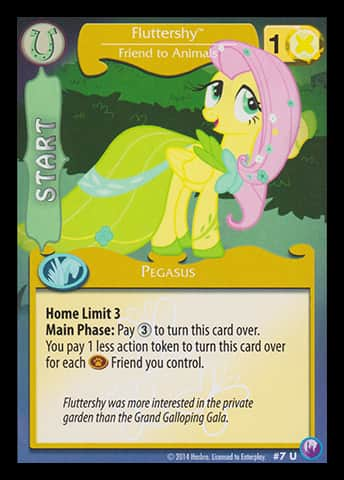
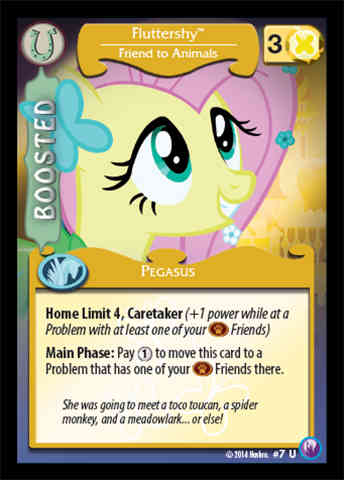 Like Magic: The Gathering‘s Commanders, manes invite players to identify with the game and the decks they build. A mane can be a strategic choice, to support a strategy you want to build around, or it can be a personal preference: maybe you really like Lyra or Octavia, and want to make a deck that features them.
Like Magic: The Gathering‘s Commanders, manes invite players to identify with the game and the decks they build. A mane can be a strategic choice, to support a strategy you want to build around, or it can be a personal preference: maybe you really like Lyra or Octavia, and want to make a deck that features them.
Of course, it wouldn’t be My Little Pony if you weren’t going on friendship adventures. In the game, these take the form of Problem cards, which represent the dilemmas your ponies will have to work together to solve. Most Problems are themed after central conflicts or favorite moments from actual episodes:
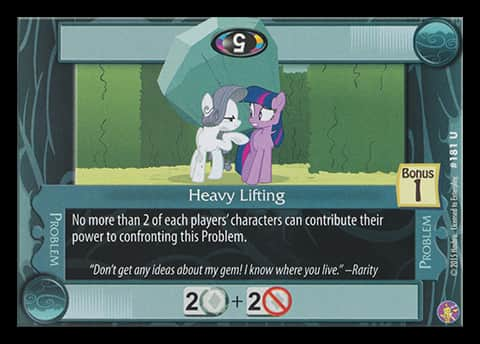
Problems have varying confront requirements, shown on the upper and lower edges of the card. You need Friends with that much total power to “confront” the problem, which scores you a point at the end of your turn. Confront requirements usually include color, too: in the case of Heavy Lifting, you need two power from a white friend, and two power from another friend that isn’t white.
Your opponent can also confront the Problem, which is reflected in the “5” on the upper border. That 5 can be any color, though your opponent has to bring a little more power to confront the Problem than you do. Usually, your opponent’s Problem will be more difficult for you to confront, but in the course of play Problems can be blocked off by various cards, so having two Problems presents options and keeps the game moving.
Each player brings a deck of 10 Problems to each game, which are set between the players like so, forming the play locations the game takes place in:
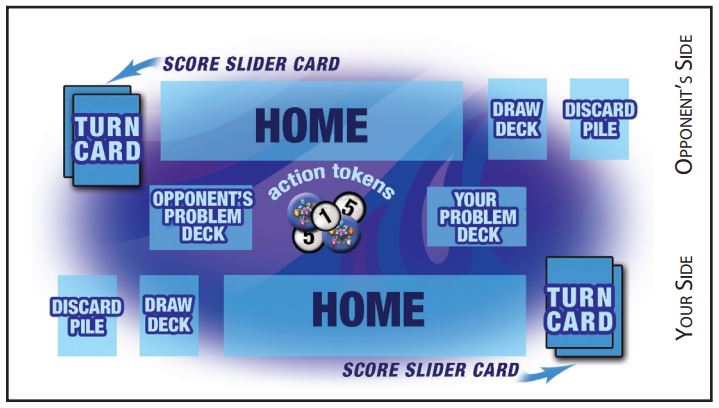
In the diagram above, your “Home” is a zone your Friends can stay in when they’re not at a Problem. During your turn you can move Friends from Home to a Problem and back, if you like. You’re likewise free to move or play your Friends to either Problem, so you can try to confront your Problem or your opponent’s (or both).
From time to time, both players will find themselves confronting the same problem at the same time. When that happens, players have a faceoff to see who solves the problem: they add the powers of all their friends at the problem, then each player flips the top card off their deck and adds that card’s power, as well. Whoever has the highest total wins the faceoff and scores the bonus points shown on the problem. The problem is solved, and a new problem is flipped up from the problem deck. If one player confronts both Problems, there’s a double problem faceoff—an epic fracas where all Friends at all problems compare power to see which player will score bonus points.
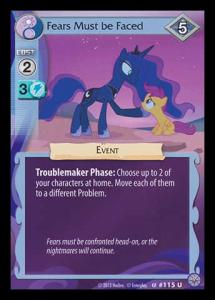
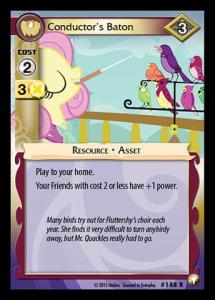
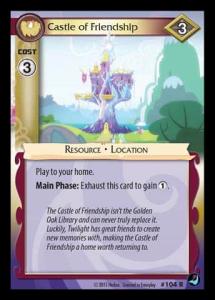 Resouce and Event cards give you ways to help your Friends, overcome Problems, or mess with your opponent. Events are the equivalent of spells: they have a one-time effect and then are put into the discard pile. Events can fix colors, draw cards, dismiss friends, or give you a boost in a faceoff. Resources are permanent cards that stay in play on your side and give you a persistent bonus, or an extra ability to use once per turn. Like Friends, Events and Resources sometimes have an entry requirement you’ll need to meet with the Friends you have in play.
Resouce and Event cards give you ways to help your Friends, overcome Problems, or mess with your opponent. Events are the equivalent of spells: they have a one-time effect and then are put into the discard pile. Events can fix colors, draw cards, dismiss friends, or give you a boost in a faceoff. Resources are permanent cards that stay in play on your side and give you a persistent bonus, or an extra ability to use once per turn. Like Friends, Events and Resources sometimes have an entry requirement you’ll need to meet with the Friends you have in play.
![]()

 Troublemaker cards represent the antagonists of the My Little Pony world, and you can use them to waylay your opponent. Troublemakers are played to your opponent’s half of a problem, and block them from confronting it until the Troublemaker is dismissed, defeated, or otherwise bypassed. They’re not insurmountable, but can give you a few turns to get a few points ahead. Sometimes, they’ll give your opponent a point or two when they’re defeated, for the trouble they made. Rare Troublemakers called Villains send Friends scrambling for cover and can block both players from confronting a problem.
Troublemaker cards represent the antagonists of the My Little Pony world, and you can use them to waylay your opponent. Troublemakers are played to your opponent’s half of a problem, and block them from confronting it until the Troublemaker is dismissed, defeated, or otherwise bypassed. They’re not insurmountable, but can give you a few turns to get a few points ahead. Sometimes, they’ll give your opponent a point or two when they’re defeated, for the trouble they made. Rare Troublemakers called Villains send Friends scrambling for cover and can block both players from confronting a problem.
Players pay for all these fun cards with action tokens (AT). At the beginning of each of their turns, a player gets a few more AT to spend. AT don’t go away from turn to turn (unlike mana in Magic or Hearthstone), so you can “bank” them to save up for more expensive cards.
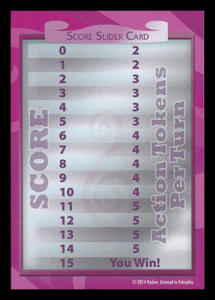

As players score more points, they get higher amounts of AT each turn, so the number of things they can do increases. (The two cards pictured lay on top of each other to help players keep track of their current score and how much AT players should receive.) AT gain makes for a nice pacing mechanic: the game starts slowly, but speeds up toward the end, and players get to feel more powerful each step of the way.
AT can also be used for a few other game actions, pictured on the Turn Card: drawing cards, moving Friends between problems, and so on. Often, playing cards from your hand will be your best choice, but it’s nice to have options. In particular, if you aren’t able to play a card on a given turn, spending AT to draw means you don’t feel completely helpless.
So that’s the game in a nutshell: play Friends, confront Problems, score points. Help your friends with Resources and Events. Hinder your opponents with Troublemakers. How does the game stack up? Honestly, it’s pretty great.
Sharing, Kindness
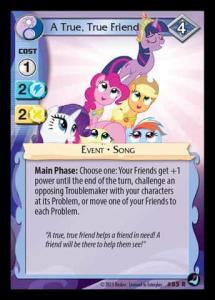 Thematically, the game does a great job expressing the overall sentiment of the My Little Pony show. This is a challenge for a 1v1 card game, where player interaction necessarily involves removing your opponent’s cards from play. Part of this is linguistic: Friends aren’t “destroyed” or “sacrificed,” but rather “dismissed” or “retired.” On a deeper level, the game avoids direct conflict between the players and their Friends. Even when you’re in a faceoff, you’re really just competing to see who is solving the Problem more.
Thematically, the game does a great job expressing the overall sentiment of the My Little Pony show. This is a challenge for a 1v1 card game, where player interaction necessarily involves removing your opponent’s cards from play. Part of this is linguistic: Friends aren’t “destroyed” or “sacrificed,” but rather “dismissed” or “retired.” On a deeper level, the game avoids direct conflict between the players and their Friends. Even when you’re in a faceoff, you’re really just competing to see who is solving the Problem more.
Meanwhile, Problems almost always require two Friends to confront (and usually require two different colors of Friends), which makes the game feel like it’s about teamwork in a fundamental way. Friends with different attributes have to work together. It’s the only way things get done.
A Beautiful Heart
Strategically, I’ve found the game to be an interesting twist from Magic and other CCGs. There’s a surprising amount of mechanical complexity, both in terms of individual cards, which are often sophisticated designs, and combinations of multiple cards working together. Members of our playtest group have put together some pretty intricate combo decks, which is really only possible when the developers put powerful tools in the players’ hands. Decks built around a single mechanic, card, or theme, feel as cohesive as any I’ve played in a CCG.
Various aspects of the design are subtly impressive, particularly how the flow of the game helps keep play competitive. The gradual boosting of action tokens as the game progresses, for example, serves as an elegant catch-up mechanic. Once one player hits the point threshold for increasing AT awards, both players get that much AT at the start of each of their turns. So, if your opponent gets off to a fast start and scores 2 points before you score any, you’ll get the first crack at a turn with 3 AT, to help you get back in the game. Similarly, if you force a face-off, your opponent will have first crack at the fresh Problem(s), so they can score a point or two to try to keep pace.
Faithful and Strong
That’s not to say everything’s perfect. Some of the game’s best cards can be oppressively powerful, and the high-level tournament metagame is pretty different from what most people would play on their kitchen tables (to a certain extent, that’s the nature of CCGs). Playing against some strategies, especially strong Troublemaker decks, can feel a little hopeless. The nature of point scoring, which naturally limits the number of points a player can score in a turn, can make it hard for aggressive strategies to put the game away. And sometimes, the best way to fight a certain strategy is to find a card that turns it off entirely.
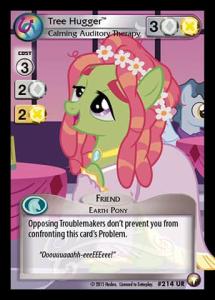
Pictured: Get wrecked, Troublemaker decks.
But a lot of these issues can be circumvented in a supportive play group. MLP CCG is a deep, rewarding game with a lot of cool decks to build and a lot of neat interactions to explore, and a convivial group can give each player
Big Adventure
This is actually a pretty great time to get into the game, since recent sets (Absolute Discord, Equestrian Odysseys, and High Magic) have really been killing it. They reflect a lot of great choices that make the game more fun for more players. (For the reconrd, these are sets that were finished before I started playtesting.)
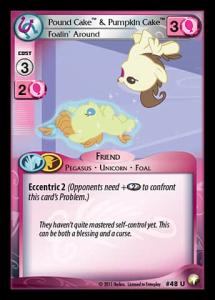

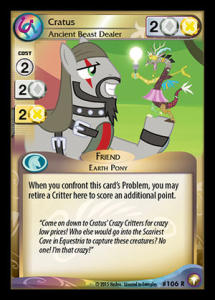 Mechanics like Vexing and Eccentric, both recent additions, encourage interactive play without shutting the game down completely—they give ways to challenge an opponents’ ability to confront problems, still feels manageable and fun to play against. Recent sets have also featured a host of multicolor cards, many of which inspire new decks. These cards show up at accessible rarities, so newer players have a good chance of finding them. Honest to goodness, MLP CCG is among the best games I’ve seen for spreading powerful cards down to common and uncommon.
Mechanics like Vexing and Eccentric, both recent additions, encourage interactive play without shutting the game down completely—they give ways to challenge an opponents’ ability to confront problems, still feels manageable and fun to play against. Recent sets have also featured a host of multicolor cards, many of which inspire new decks. These cards show up at accessible rarities, so newer players have a good chance of finding them. Honest to goodness, MLP CCG is among the best games I’ve seen for spreading powerful cards down to common and uncommon.
The developers also recently announced a change to the way Problem bonus points work, which makes it more strategically attractive to induce Faceoffs with your opponent. Faceoffs are the most exciting moments of the game, and they’re one of the things new players are drawn to because they seem like (and are) fun. Rewarding attractive, exciting plays is a great step.
All in all, it’s a great time to get started. MLP CCG, incidentally, has excellent intro decks; they play well against other intro products out of the box, include a number of powerful cards, and offer clear directions for improvement. Oh, and the sets draft well, too—our group likes to draft four packs for each player, and add a few copies of Kevin, Fitting In at the end of the draft to help fix colors.
Tons of Fun
MLP CCG is a game with a lot of heart and a lot of love. The card concepting is stellar; the creative team does a great job of capturing the show’s most iconic moments and most beloved characters. Many of the cards’ subtitles and flavor texts are legitimately funny, full of winks and nods at inside jokes from the My Little Pony fandom and other popular shows.
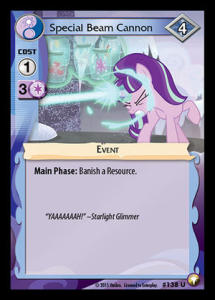
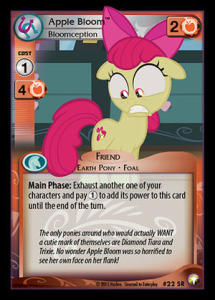
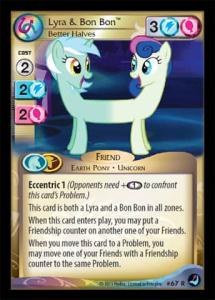 Favorite characters like Lyra, Bon Bon, and Dr. Hooves, who tend not to get much screen time in the show, have several cards each. (There are also plenty of cards for the mane six, so fans who are excited to play with their favorite characters will have no trouble.) Somehow, the game strikes the right balance of appreciating the passionate fan following MLP has found outside its target demographic, while not making the IP about those fans.
Favorite characters like Lyra, Bon Bon, and Dr. Hooves, who tend not to get much screen time in the show, have several cards each. (There are also plenty of cards for the mane six, so fans who are excited to play with their favorite characters will have no trouble.) Somehow, the game strikes the right balance of appreciating the passionate fan following MLP has found outside its target demographic, while not making the IP about those fans.
Magic Makes It All Complete
That might be the best compliment one can give to a game like this: given the IP it’s representing, it would have been easy to make a silly card game for kids to cash in a quick buck. Instead, the designers turned out a robust game that can stand alongside the giants of the genre. MLPCCG would be a good game even without the My Little Pony flavor overlay. Add a little Friendship, though, and you’ve got some real magic.
My Little Pony Collectible Card Game is designed and developed by Enterplay, LLC, which licenses the My Little Pony IP from Hasbro. Packs have an MSRP of $3.50, and intro decks have an MSRP of $10.99. Players require a 45-card main deck, a 10-card problem deck, and a Mane character to play.
